
How to create a Multi-Language product feed using WPML on CTX Feed Pro
Introduction
You can create a multi-language product feed by connecting WPML (WordPress Multilingual Plugin) with CTX Feed – WooCommerce Product Feed Plugin on your WooCommerce store.
WPML handles product translations, language, and currency, while CTX Feed Pro generates channel-ready product feeds (for Google Merchant Center, Facebook, etc.) using those translations.
By selecting a language and currency attribute in CTX Feed Pro’s feed settings, each feed automatically outputs localized product titles, descriptions, URLs, prices, and taxonomies, making your WooCommerce products ready for international marketplaces.
Today, we will discuss How to create a Multi-Language product feed using WPML on CTX feed pro.
Importance of Language Translation for eCommerce website
If you are running an eCommerce website, you already know that the competition is immense and constantly growing. However, multi-language is a critical option that you must consider in your virtual store. We are now presenting the importance of language translation for eCommerce websites.
Reach Out to a Wider Audience
Having a multilingual site means thousands or even millions of online shoppers can easily purchase from your store. Would you really miss out on this vast sales generation opportunity?
The modern era of the internet allows you to expand your business globally by targeting English-speaking customers. Yet, what about the 75% of customers who are speaking other languages? By including other languages on your website, you will surely get more customers to your online store.
If you go to Nike’s official website, the first thing that will pop up is an interface where you must select your region. In addition, the website successfully translates the English language into your selected language.
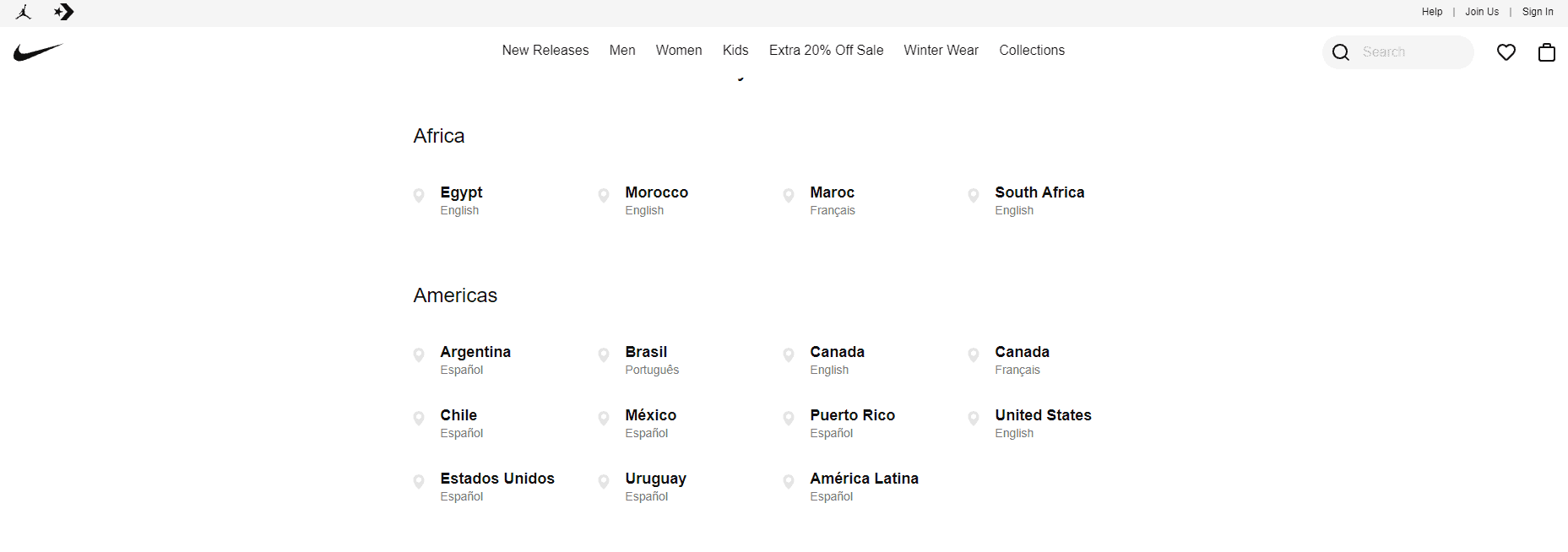
A vast audience over the internet, around 72.4 percent, would like to purchase from a site that includes their own language. Therefore, it’s really an essential feature, which you must include in your website. Another 56.2 percent of the customers prefer to get product information in their native language. Surprisingly, they don’t even care about the price of the product and make a purchase.
Add Up to Your Competitive Advantage
At present, 25.3 percent of the world’s population speaks English for communicating over the internet. Therefore, you must have a multilingual site to get ahead of the competition and expand your business internationally.
In this highly competitive marketplace, you have to get ahead of your competitors. Therefore, include features such as a language translation on your website. As a result, your website will become more user-friendly compared to your competitors.
There is no doubt that the opportunity to reach out to customers around the world is highly tempting. But let’s not forget that various languages are spoken in a specific country as well. Therefore, owning a multilingual website is the wisest option to get a competitive advantage. As a consequence, you can easily target both domestic and international customers.
Minimize the Bounce rate & Improve the Conversion
As we mentioned earlier, a vast number of customers online prefer to spend time on a website that includes their native language. Foreign customers are less likely to leave your website if you have a multilingual feature enabled. As a result, it increases the conversion rate of your website.
As you get more customer engagement with your multilingual website, the bounce rate falls inversely. This is because it will be easier for your customers to understand every step of their buying journey.
Economical Marketing Approach
In recent times, the marketing strategies of an eCommerce business are mostly website-centric. From your website, you can efficiently promote your products & offers to align the cost and audience reach.
Moreover, it’s one of the most cost-effective approaches that generate improved leads. After all, we can say a multilingual website is a great way of implementing international marketing strategies.
Boosting the Brand Image
In this era of eCommerce, businesses have to acquire new trends to attract customers. A multilingual site is one of the trends to improve brand image innovatively. Since it boosts your brand image by getting customers’ acceptance.
A website with multiple language availability means you are good to go with international customers. In addition, it adds simplicity, user-friendliness, and elaborateness to your site. As a result, customers from around the world will connect with your business in a professional manner.
SEO Optimization for International Marketplace
Your success in the online marketplace or eCommerce journey depends on your visibility on search engine result pages (SERPs). That is due to a huge number of prospects are searching for products online- 2.14 billion in the year 2021.
Nowadays, it has become necessary to rank higher on shopping or default search engine result pages for many reasons. The higher you rank on the search engine output, the easier the consumers will discover you. Eventually, you will be able to generate increased sales and revenue from your business.
You may be well aware of SEO and ranking higher in domestic search engine result pages. However, think internationally when it comes to attracting foreign customers who speak different languages. It’s not only about translating the contents of your website but also getting recognition for international SEO.
Your website data should be 100% translated into a targeted language, including metadata. Even the site URLs that have specific subdirectories should be displayed with the language specifications. After meeting these requirements, your website will be easily discoverable by search engines.
It sounds like a complex task to complete, right? But with innovative plugins such as WPML, you will be able to translate almost every information of your WooCommerce website. Besides, creating a multi-language product feed is also possible via the WPML plugin.
Even you can create a product feed for Dokan multivendor websites by using the CTX feed – WooCommerce Product Feed Generator Plugin.

What is WPML?
Before you learn what WPML is, it’s mandatory to get some insight into the WooCommerce website. WooCommerce is a sophisticated eCommerce platform that you can use to establish an online store via WordPress. The current stats of WooCommerce will amaze you!
Currently, there are 28.19% of online stores powered by WooCommerce. Among the top-ranked eCommerce websites, around 22% uses WooCommerce. Moreover, when it comes to website users on the internet, the WooCommerce user ratio is 7.4%.
Now, let’s discuss WPML in detail.

WordPress Multilingual Plugin (WPML) is a renowned language-translation tool that perfectly integrates with WooCommerce. This tool can translate the languages of any small or huge business website.
On a single WordPress website, you can translate your site content into 40+ different languages. In addition, you can place each language on the same domain or your chosen subdomain. Hence, making it a good fit for your WooCommerce site to expand business objectives.
WPML plugin allows your website to automatically translate the language of your website according to the region. Moreover, you can manually change the site language by selecting it via this tool. But the translation process does not affect the SEO and improves the overall quality of your WooCommerce website.
Another mentionable feature of MPML is – the capability of setting language roles according to users. Therefore, if your team members speak different languages, this feature will really help them to communicate.
Key Features Highlighted
By combining WooCommerce and WPML, you will be able to utilize these features:
- Translate the product information of your WooCommerce website. (Simple, grouped, and external product )
- Easily translate and manage your product’s categories and attributes
- Select the chosen language and keep it the same until the checkout process
- Send personalized emails to your customers and group members in their preferred languages
- Track your inventory without splitting products down into languages
- Within a single WooCommerce website, enable multiple currencies based on customer’s region
- Enable a variety of payment gateways according to the customer’s location.
Creating multi-language product Feed with WPML
The WPML plugin integrates perfectly with the WooCommerce website and other plugins such as CTX Feed Pro. As a WooCommerce site owner, you must be thinking of multi-channel product promotion. Thus, you’ll have to create a product feed and then transfer it to your chosen marketing channel. It can completely translate your product feed file into a chosen language thanks to the WPML plugin.
First of all, you have to install and activate the WPML plugin on your WordPress website. With a proper configuration, you can select the preferred language from the content settings area. In addition, you can also change the currency for international customers via WPML.
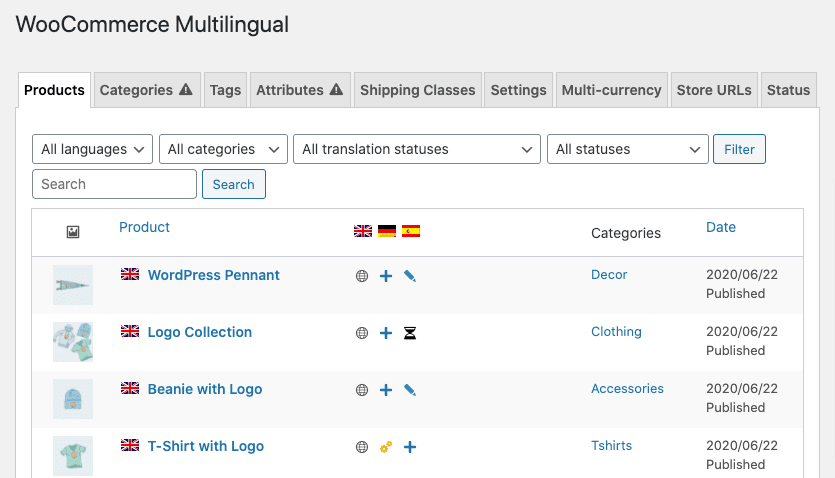
CTX Feed Pro – The tool to create a multilanguage-product feed
CTX Feed Pro is a blaster when it comes to creating a product feed with an accurate format and complete information. This renowned product feed generator plugin syncs with the WPML plugin to create a multi-language product feed. As a result, you can expand your business agenda to customers from foreign countries.
CTX Feed Pro allows you to create unlimited product feeds for countless products of your store. Besides, after creating a feed file, you can upload it to your chosen channels, such as Google, Facebook, and more. Creating a feed file is easygoing as it includes 100+ pre-built templates for different channels.
Consider how your conversion rate will improve after people from all around the world may shop at your store. Yes, they won’t be exiting your store if you can display the product information in their preferred language. You can upload the product information in different languages in association with WPML.

Now, let’s learn the installation process and usage of CTX Feed Pro and WPML altogether.
Getting Started
To create a Multi-language product feed, you need some plugins installed and ready on your WordPress dashboard. We are providing you with a list of plugins that you need to install at first:
- WooCommerce Plugin
- CTX Feed Plugin
- WooCommerce Multilingual Plugin
- Translation Management by WPML
- WPML Multilingual CMS
- String Translation by WPML
After installing these plugins, activate them and go to your “Plugins” section of your WordPress dashboard. Here, you can see all the plugins that are installed and, if activated properly.

Navigating WPML to create Multi-language Product Feed
Step 1 – Selecting Language in WPML
You’ll notice the WordPress Multilingual Plugin on your dashboard once it’s installed and ready. To begin, select “WPML” to enter the tool’s interface, where you’ll find an option called “Site Languages.”

In the “Site Languages” section, you will notice the default language is set to English. Here, you can select the language of your preference. The language you select here can be chosen later while creating a multi-language product feed.
For exemplary purposes, we have selected “French” & “German.” You will get the “Language Switcher” option on the same page by scrolling down a bit. Please read the official WPML documentation if you want to learn more about additional WPML functionalities.
Step 2 – Creating a Product Feed File
Let’s head into the “CTX Feed Pro” plugin’s user interface after clicking it from the WordPress dashboard. If you click the “CTX Feed” plugin, you will see there is an option called “Make Feed.” By clicking the “Make Feed” option, you will notice the user interface popping up with a heading, “Content Settings.”
In the Content settings area, you have to do the following to create a multi-language feed file:
- Select the country or the origin of your business
- Choose the merchant center template (We’ve chosen Google merchant )
- Name your feed file as you want
- According to the merchant center’s requirements, select the feed file type
- Select the language of your feed file from the “Language” option
- You can also set the currency according to your customer’s location
After you’ve specified all of these parameters, click “Update and Generate Feed File” to construct the feed file. Once you are finished generating a feed file, go to the “Manage Feed” option to view it.
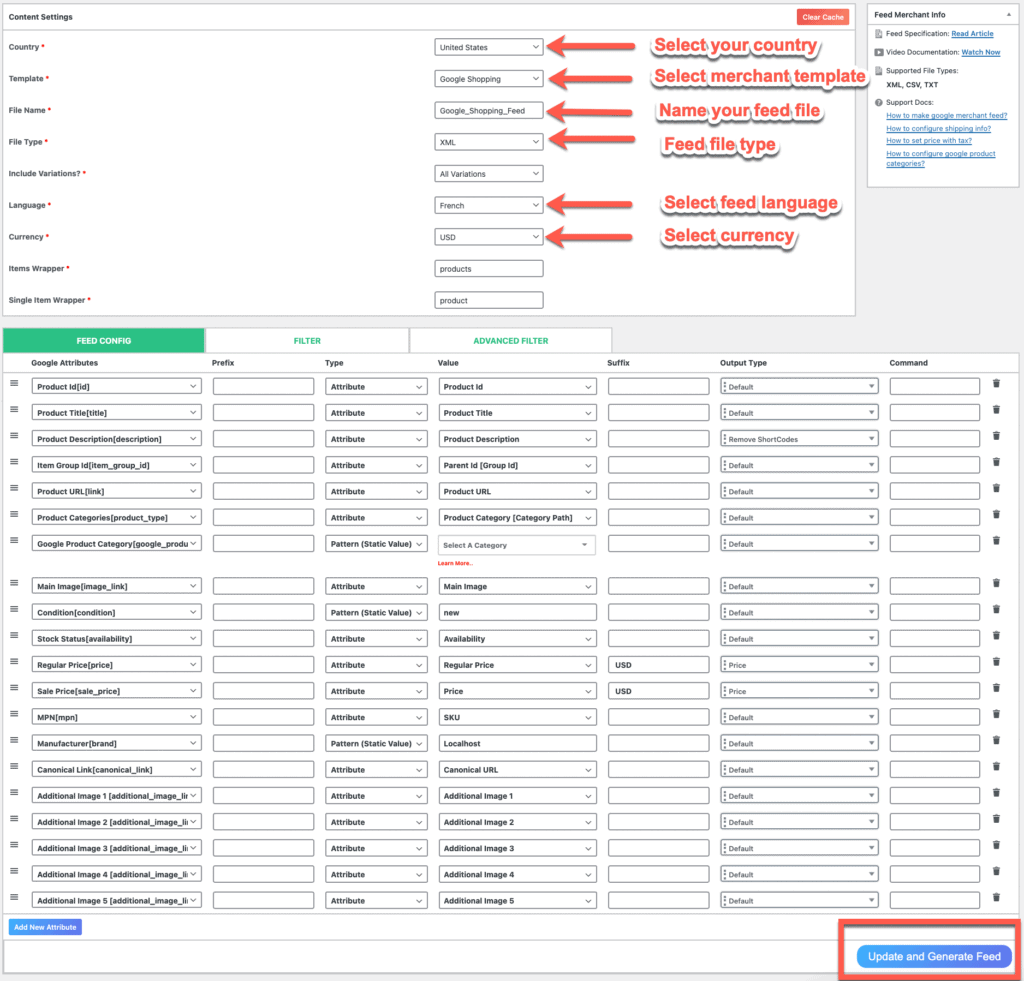
There you go, you’ve completed a major step by creating a feed file with your selected language.
Step 3 – Manage Feed Option of CTX Feed
In this step, select the “CTX Feed” Plugin and then click the “Make Feed” option. After clicking the “Make Feed” option, you’ll be able to view the feed files that you’ve created previously. As you can see in the image below, we’ve created a feed file named “custom1.”

From here, you can download the feed file or share the link to the merchant center website to provide your feed file. This feed file contains the language that you have chosen in step 2.
Step 4 – Setting up Language in Content Settings Area
We are now unfolding the process of changing the language on a feed file. However, we will be doing this to show you how easily you can create a multi-language product feed with CTX Feed.
First of all, click the feed file that we’ve shown in your previous step. As a consequence, you will be redirected to the content settings area again. Here you will see an option named “Language” where you can select your preferred language.
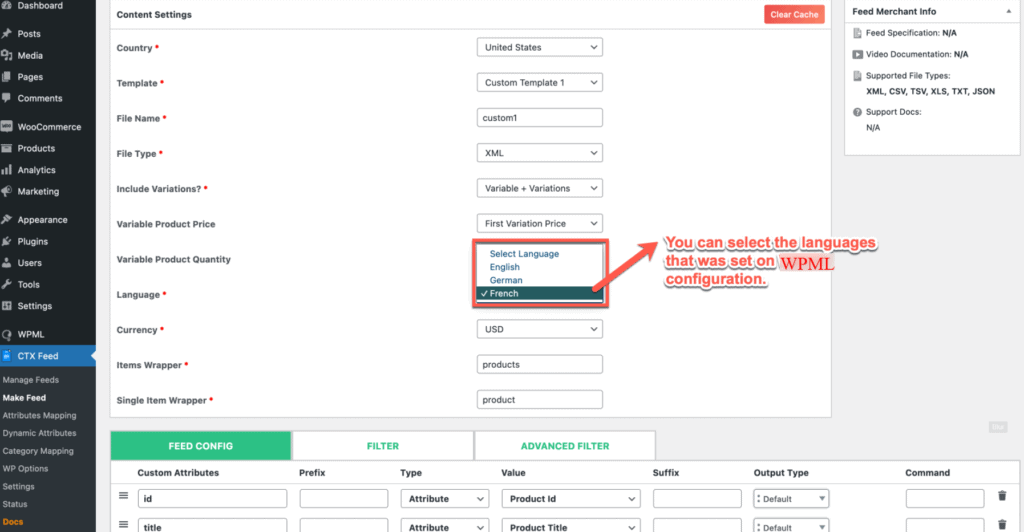
Select your preferred language from the dropdown menu in the “Language” section. Although, the “Language” option in the CTX Feed plugin is activated after installing the WPML plugin.
Step 5 – Select Language on Product Page
Assume, you’re putting out product information for your website. Fill in all of the required information in the “Product” area, and choose a language from the “Language” section. We’ve pointed out the language option on the image below, named “Language of the product.”

For example, we previously produced product information and chose “French” as the language. As a result, the product information will be shown in French. You may also display the product information in the German language by enabling it on the product information page.
Selecting the language from the “Language” section is a direct approach, but you have more to process. Therefore, we are moving to a more detailed approach to translating the product information. Please look closely at the following instructions or learn more from the documentation section of WPML.
To enable the German Language, you have to head down to the “Translate this Document” section. Here you can see different languages are available, and you have to choose German from the list. After selecting “German” from the list, you will be taken to another page where you have to complete the translation process.
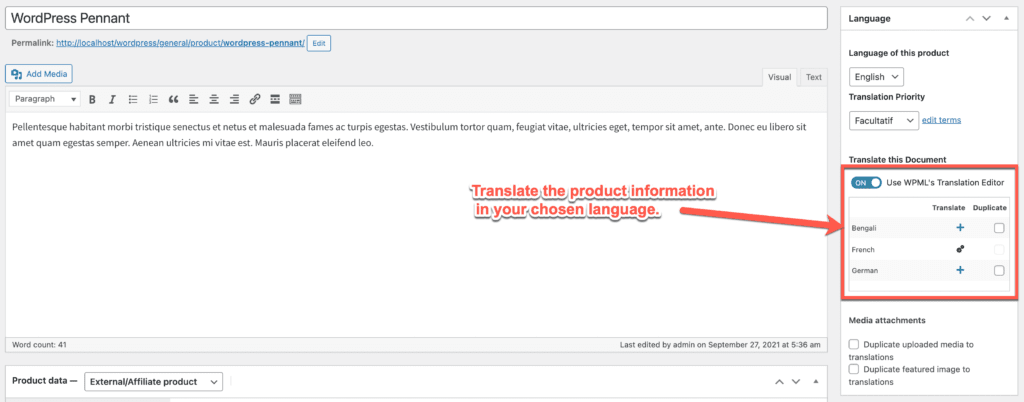
After selecting “German” from the list you will be taken to another page where you have to complete the translation process. On the left side, you will be able to see the default language is set to English. On the right-hand side of the screen, you will see the chosen language which is “German”
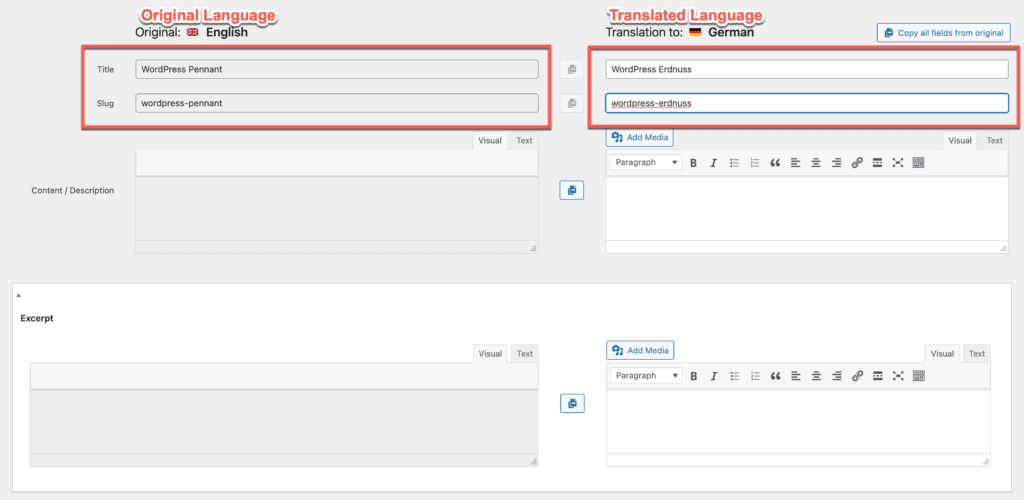
Now provide the translated product information “Title” and “Product Description” in the German Language. Now you may click the save button and proceed to the next step.
Step 6 – Changing the Language in Content Settings Area
Now, we will be showing you the process of selecting another language for the feed file. Simply return to the “Manage Feed” section and choose “custom1” once more. Consequently, you will be redirected to the Content Settings area. Let’s select the language option and select “German” from the dropdown menu.
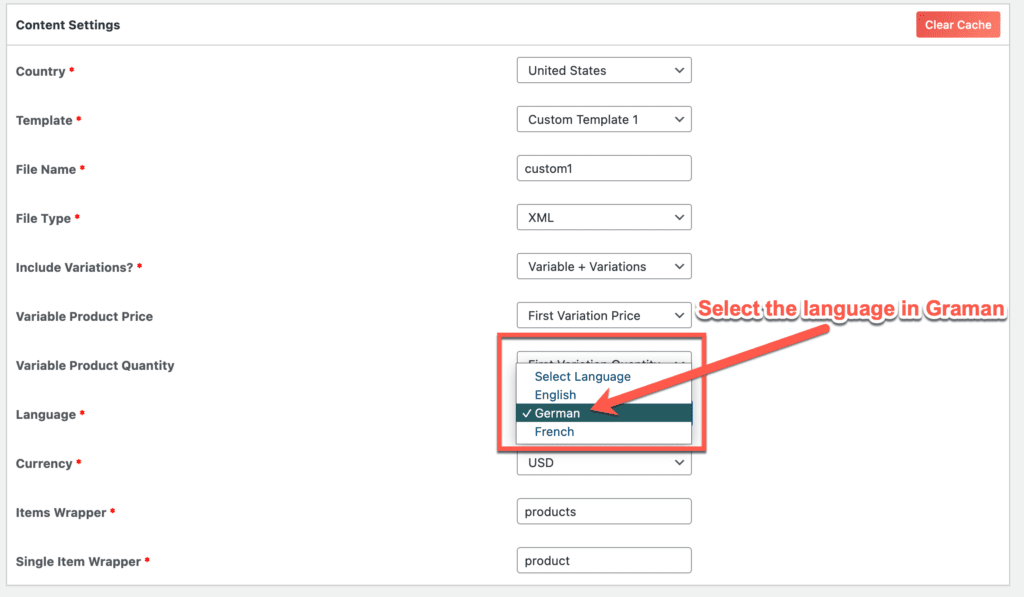
Scroll down and click the “Update and Generate Feed” button after you’ve set up the language. You will be routed to the Manage Feed Option at this moment.
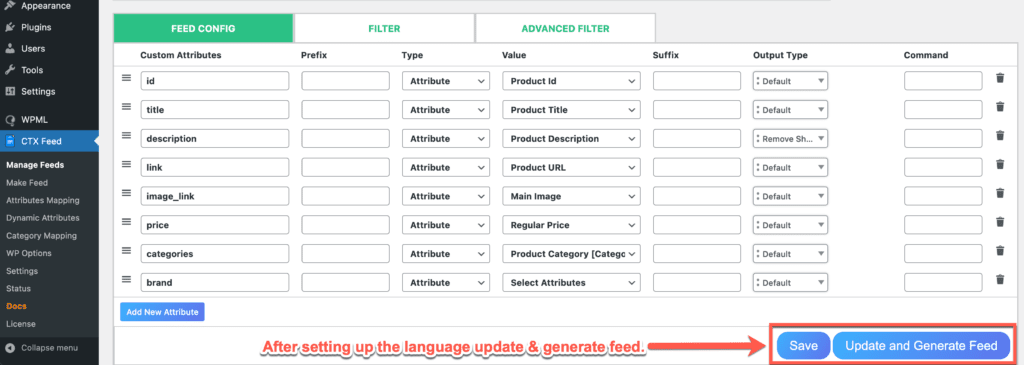
Step 7 – Download and View the Feed File
The “Manage Feed” option now displays the feed file you’ve created. We’ve highlighted the button you’ll need to tap to download the feed file. After downloading the feed file to your system, you may examine it more closely.

Step 8 – Viewing the Multi-Language Product Feed File
Let’s open the feed file that we’ve downloaded previously and check the language of the product information. As you can see, the language of this feed file is “German,” which we have selected in the content settings area of the plugin.
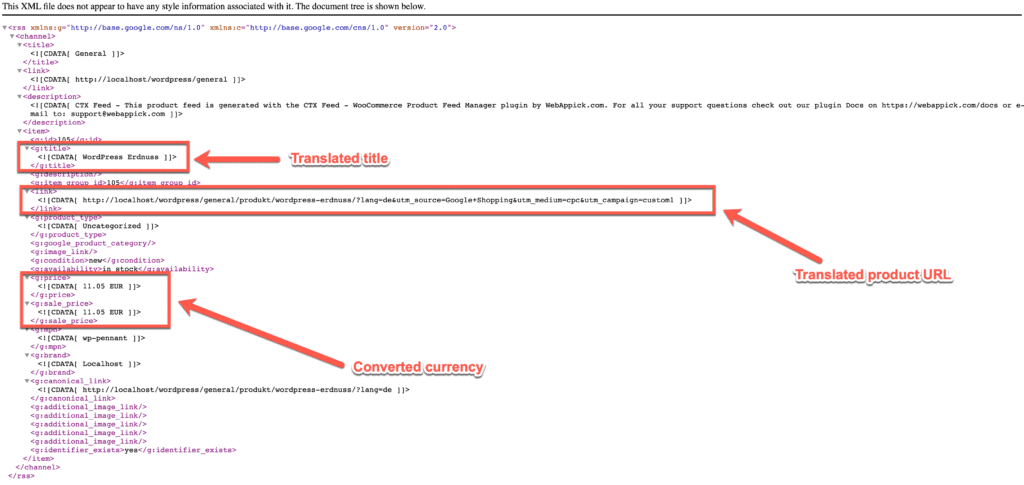
In addition, the product URL is also translated along with the currency, which we’ve pointed out in the above image. Apart from creating a product feed with your selected language, you can also translate:
- Products price or currency
- Product taxonomy
- URL of the products
To make the multi-language product feed generation process easier, we are sharing a video tutorial on -How to make a multi-language product feed. This tutorial will surely minimize your effort in creating the feed on your suitable language.
Let’s watch this video!
Wrapping Up
There you go. You’ve successfully created a multi-language product feed file via CTX Feed Pro and WPML plugins. You can now upload your product feed to other merchant sites in different languages. As a result, customers can translate the merchant site’s language and get the product information in their preferred language.
If you want to market your product and brand globally, you must create a multi-language product feed. That is because foreign customers will prefer your site to be displayed in their native language. Furthermore, people will not seek out other choices if they can receive all the information from your website. Therefore, we highly recommend you using CTX Feed and WPML plugin on your WooCommerce website.


Ecellent article! We will be linking to this great post on our site.
Keep up the great writing.